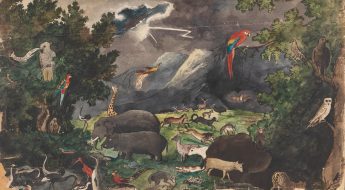Book of the Week: Shark Week, Part 2. The Mythology of the Shark

Welcome to Part Two of our Shark Week Book of the Week feature! If you recall from our last post, this week we’re featuring the book Shadows in the Sea (1963) by Harold W. McCormick. Last time, we highlighted shark attacks. This time, we’re recounting the various roles sharks have played in legend and mythology throughout the ages. Sharks have been revered as gods and powerful spiritual beings for thousands of years, long before Zeus, or even Cronus, debuted on the scene. As McCormick writes,
“As the Greeks wrote their myths in the constellations, Orion, the mighty hunter, wheeled across the winter sky in eternal, futile pursuit of Taurus, the great bull, and Leo, the couchant lion. But long before the Greeks looked skyward and evolved their myths, primitive men discerned in the flickering pattern of the stars cosmic enactments of their fearsome struggles with their own devil-god – the shark.”
Like the Greek gods, sharks also have within their repertoire a constellation myth, as told by the Warrau Indians of South America. For this tribe, Orion’s Belt has a far more sinister backstory – it is a severed human leg. According to the legend, the leg once belonged to Nohi-Abassi, who schemed to kill his mother-in-law by enticing a hungry shark to eat her. Unluckily for him, however, his sister-in-law, “playing the role of a shark,” cut off his leg. Nohi-Abassi died, and while his leg now rests in the sky as Orion’s Belt, the rest of him wound up in an altogether less celestial place.

Also like the Greeks, whose gods were constantly cavorting with human women and begetting demi-gods, many Hawaiian myths tell of similar erotic behavior among their shark gods. Legend tells that Kamo-hoa-lii, king of the sharks, fell in love with Kalei, a human, and transformed himself into a man to marry her and bear a child with her. “The child, Nanaue, looked like any other child – except that on his back he bore the mark of his shark-father, the mouth of a shark.” The story does not end well for the child, who devoured many islanders after the taboo of never being fed animal flesh was broken, presumably birthing an insatiable desire for human flesh. He was eventually caught – in his shark form – and taken to a hill in Kain-alu that still bears his name.
A staple of ancient Roman culture also bears a grisly similarity to the history of cultural practices involving sharks. While the Roman gladiator practice of pitting man against land beasts like lions or tigers is fairly well-known to most people (thanks in large part to Hollywood), gladiator games involving sharks are perhaps somewhat less well-known. But, like Sparatcus, Hawaiian warriors were also matched against fearsome killers for imperial entertainment. Shark pens constructed of large lava stones encircling a 4-acre area at the edge of a bay served as the den for the sharks. Fish and human bait were used to lure sharks into the pens, and Hawaiian warriors battled for their lives using a shark-tooth dagger, which was simply a single shark-tooth affixed to the end of a long stick. The warriors had a single opportunity to prevail: they must allow the sharks to charge them, attempting to dive beneath the shark at the last moment and use the shark-tooth dagger to slit the underside of the shark open.

Sharks also find themselves on the list of species with mistaken identities. Just as manatees and similar creatures have been mistaken for mermaids throughout history, so, too, has the shark been given this misnomer. In the town of Bregenz, Austria, a severely contorted, mummified shark has hung from an archway as a reputed “mermaid” guarding the town since, allegedly, the thirteenth century. Legend tells that a fisherman brought the “mermaid” in with his catch early one morning, but before he could return it, the “Spirit of the Lake” told him to hang her from the Arch of the Martinster as she was “beget of a land woman and…of no use [in the water].” Dr. Denys W. Tucker of the British Museum “tentatively identified the mermaid, from a photograph, as a mummified Porbeagle shark.”
The chapter has many more stories to tell. One myth explains how various species of sharks were created as a result of an especially cruel young woman beating, squishing and lashing various sharks. Another relates how two particularly lazy sharks laid still for so long that they became islands. Some cultures tell a Jonah and the Whale type story which would be more aptly named “Jonah and the Shark.”
Moving past myth to historical fact, our book of the week describes “shark charmers” and holy men who kiss sharks in order to overpower and subdue them. Throughout history, holy wars have been fought among tribes, resulting from one tribe inadvertently or otherwise catching and/or defiling the sacred shark species of another tribe. Sharks have even played a central role in the resolution of documented crimes throughout history!
It truly is worth the time to read through this chapter of our book of the week, as it recounts the rich history of the shark as it has evolved through cultural experience. Maybe it will inspire you to see something other than a belt in the night sky 🙂
And, you can see all of the imagesfrom our book of the week, Shadows in the Sea (1963) by Harold W. McCormick, on our Flickr site.





Leave a Comment